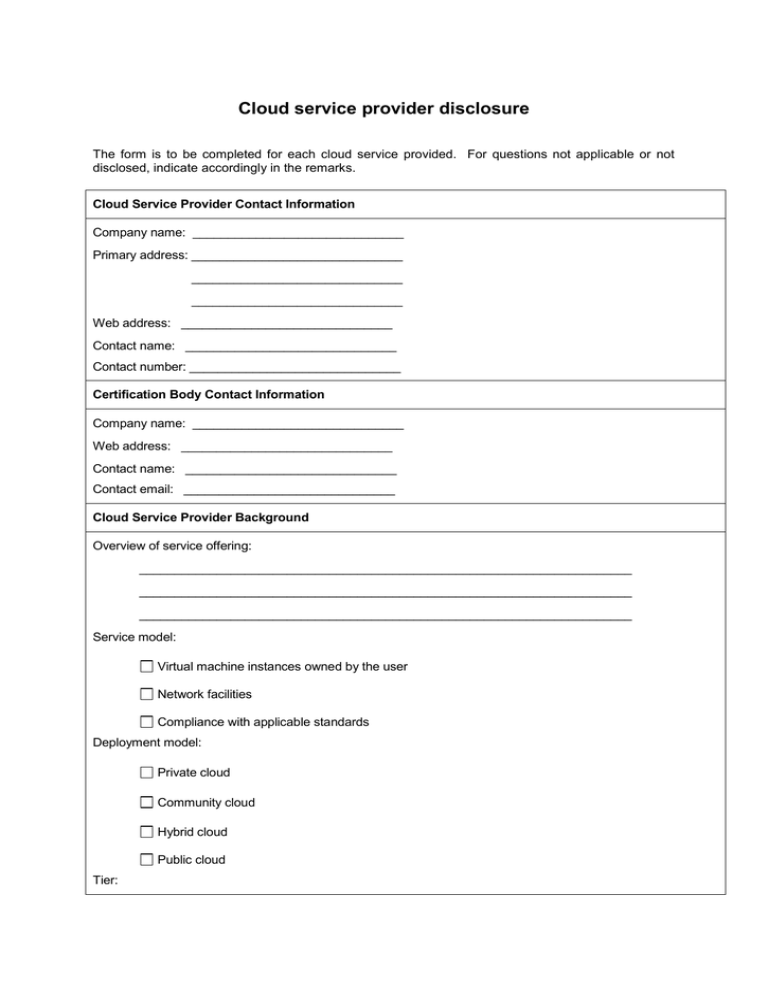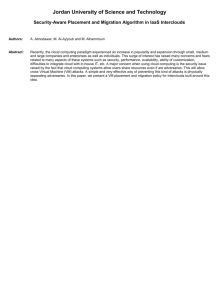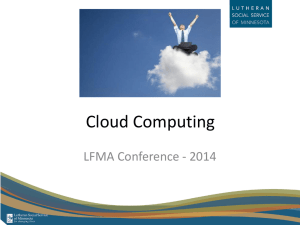Self-Disclosure form
advertisement

Cloud service provider disclosure The form is to be completed for each cloud service provided. For questions not applicable or not disclosed, indicate accordingly in the remarks. Cloud Service Provider Contact Information Company name: ______________________________ Primary address: ______________________________ ______________________________ ______________________________ Web address: ______________________________ Contact name: ______________________________ Contact number: ______________________________ Certification Body Contact Information Company name: ______________________________ Web address: ______________________________ Contact name: ______________________________ Contact email: ______________________________ Cloud Service Provider Background Overview of service offering: ______________________________________________________________________ ______________________________________________________________________ ______________________________________________________________________ Service model: Virtual machine instances owned by the user Network facilities Compliance with applicable standards Deployment model: Private cloud Community cloud Hybrid cloud Public cloud Tier: Level 1 Level 2 Level 3 No. Criteria Description Legal and Compliance 1. Right to audit The user has the right to audit: Virtual machine instances owned by the user Network facilities Compliance with applicable standards Technical controls Policies and governance Data centre facilities Others ___________________________________________ None Regulators recognised by Singapore law have the right to audit: Virtual machine instances owned by the user Network facilities Compliance with applicable standards Technical controls Policies and governance Data centre facilities Others ___________________________________________ None Audit / assessment reports that can be made available on request: Penetration test Threat and vulnerability risk assessment Vulnerability scan Audit reports (e.g. Statement on Standards for Attestation Engagements (SSAE) No. 16, Reporting on Controls at a Service Organisation) Remarks 2. Compliance The following guidelines / standards / regulations are adhered to: Singapore Personal Data Protection Act ISO / IEC 27001 ISO 9000 ISO / IEC 20000 CSA Open Certification Framework PCI-DSS Others _______________________________ Data Control 3. Data ownership All data on the cloud service is owned by the cloud user except for:___________________________________________ The cloud User retains the ownership on the derived data or attributes of cloud usage except for the following: Advertising or marketing Statistics analysis on usage Others___________________________________________ 4. Data retention Data deleted by the user is retained as follows: Minimum data retention period is: ________ Maximum data retention period is: ________ Deleted immediately Log data is retained for a period of: Minimum data retention period as follows: ________ Maximum data retention period is: ________ Not retained User data is retained for a period of: Minimum data retention period is: ________ Maximum data retention period is: ________ Not retained The following types of data are available for download by the cloud user: Log data Other __________________________________ 5. Data sovereignty The primary data locations are: Singapore Asia Pacific ____________________ Europe____________________ United States Other ___________________ The backup data locations are: Singapore Asia Pacific____________________ Europe____________________ United States Other ___________________ No. of countries in which data centres are operated: _________ The user’s data stored in the cloud environment will never leave the locations specified in item 5: Yes Yes, except as required by law Yes, except as noted: ______________________ No User’s consent is required prior to transferring data to a location not specified in item 5 or a third party: Yes Yes, except as required by law Yes, except as noted: ______________________ No Note: Cloud users are responsible for determining the impact of data protection and data sovereignty laws on the locations where data is stored. In addition, users should understand the risks associated with relevant laws that may allow for law enforcement or other government access to data in-transit or storage with Cloud Service Providers. 6. Nondisclosure Non-disclosure agreement template can be provided by Cloud Service Provider Cloud Service Provider may use customer’s NDA (pending legal review) Provider Performance 7. Availability The committed network uptime is: _________________% Varies according to price plan The committed system uptime is: _________________% Varies according to price plan The cloud environment has the following single points of failure: ____________________________________________ none 8. BCP / DR Disaster recovery protection Backup and restore service User selectable backup plans Escrow arrangements No BCP / DR is available RPO____________________ RTO____________________ Others, please specify: _____________________________ ________________________________________________ 9. Liability The following terms are available for the users on failure of the provider to meet the service commitment: Network failure Liability: ____________________________________________ Infrastructure failure Liability: ____________________________________________ Virtual machine instance failure Liability:_____________________________________________ Migrations Liability:_____________________________________________ Unscheduled downtime Liability:_____________________________________________ Database failure Liability:_____________________________________________ Monitoring failure Liability:_____________________________________________ Service Support 10. Change management The Cloud Service Provider has established the following for changes, migrations, downtime, and other potential interruptions to cloud services: Communication plan and procedures for proactive notification Assistance in migration to new services when legacy solutions are discontinued Ability to remain on old versions for a defined time period Ability to choose timing of impact 11. Self-service provisioning and management portal Provide self-service provisioning and management portal for users to manage cloud services: Yes No If yes, describe the functions of the self-service provisioning and management portal provided: Allow role-based access control (RBAC) Manage resource pools (e.g. VMs, storage, and network) and service templates Track and manage the lifecycle of each service Track consumption of services Others: _________________________________________ ________________________________________________ 12. Incident and problem Delivery mode of support: management Access via email Access via portal Access via phone support Direct access to support engineers Availability of support: 24 x 7 During office hours support, please specify the hours of operations: ______________________________________ After office hours support, please specify the hours of operations: ______________________________________ Service response time: ______________________________ The following are available to users upon request: Permanent access to audit records of customer instances Incident management assistance Incident response time: ________________________________ Mean time to repair on detection of faults: _________________ 13. Billing The following billing modes are available (please elaborate granularity of charges and measurement): Pay per usage ______________ (up to per min/hour/day/month for compute/storage for IaaS/PaaS, and per user per hour/day/month/year for SaaS) Fixed pricing__________(up to yearly/monthly/daily) Other pricing model_____________ Not disclosed Available billing history: ____________Months 14. Data portability Importable VM formats: _______________________________ Downloadable formats: _______________________________ Supported operating systems: _________________________ Language versions of supported operating systems: __________________________________________________ Supported database formats: __________________________ API: Common _______________________________________ Customised _____________________________________ Upon service termination, data is available through: Physical media Standard methods as described above Other methods ______________________________ ___________________________________________ 15. Access Type of access to the service is through: Public access Private access (e.g. VPN, dedicated link) IPv6 access is supported Other access methods ______________________________ ________________________________________________ ________________________________________________ Public access speed (shared bandwidth) in Mbps: __________________________________________________ 16. User management Identity management Role based access control Federated access model Integration with Identity management solutions Others__________________________________________ 17. Lifecycle The cloud user may select the following for service upgrades and changes: Automatic provisioning User customisable provisioning Security Configurations 18. Security configuration enforcement checks Security configuration enforcement checks are performed: Manually Using automated tools How often are enforcement checks being performed to ensure all security configurations are applied? __________________________________________________ 19. Multi-tenancy Distinct physical hosts Distinct physical network infrastructure Virtual instance grouping User definable security domains User customisable firewall User definable access policies Service Elasticity 20. Capacity elasticity The following capacity elasticity options are available: Programmatic interface to scale up or down Mean time to start and end new virtual instances ______ Alerts to be sent for unusual high usage Minimum performance during peak periods______________ Minimum duration to scale up computing resources ________ Minimum additional capacity guaranteed per account _____________________ (number of cores and GB memory) 21. Network resiliency and elasticity The following network resiliency and elasticity options are available: Redundant Internet connectivity links Redundant Internal connectivity Selectable bandwidth up to ____________Mbps Maximum usable IPs ______________ Load balancing ports____________ Load balancing protocols_________ Anti-DDOS protection systems or services Defence-in-depth mechanisms, please specify: __________ ________________________________________________ ________________________________________________ Network traffic isolation, please specify: ________________ ________________________________________________ Shared or dedicated bandwidth, please specify: _________ ________________________________________________ QoS traffic control services Alerts to be sent for unusual high usage Minimum performance during peak periods______________ Minimum period to scale up network throughput __________ 22. Storage redundancy and elasticity The following storage redundancy and elasticity options are available: Redundant storage connectivity links within each data centre Redundant storage connectivity links between data centres belonging to the same cloud Storage traffic isolation, please specify: ________________ ________________________________________________ Shared or dedicated storage network bandwidth, please specify: ________________________________________________ Quality of service storage traffic control services Maximum storage capacity for entire cloud, please specify: ________________________________________________ Maximum storage capacity for single user, please specify: ________________________________________________ Maximum expandable storage, please specify: ________________________________________________ Alerts to be sent for unusual high usage Minimum storage I / O performance during peak periods ________________________________________________ Minimum period to scale up storage I / O throughput ________________________________________________





